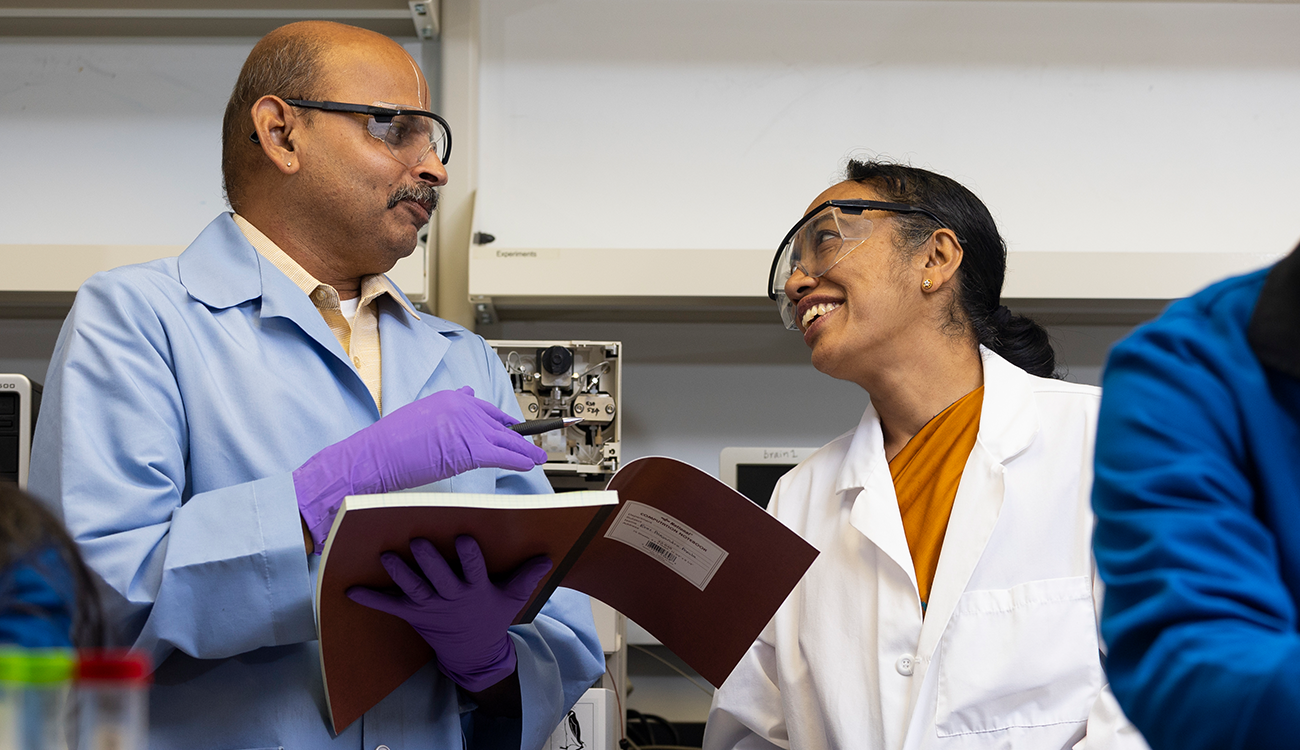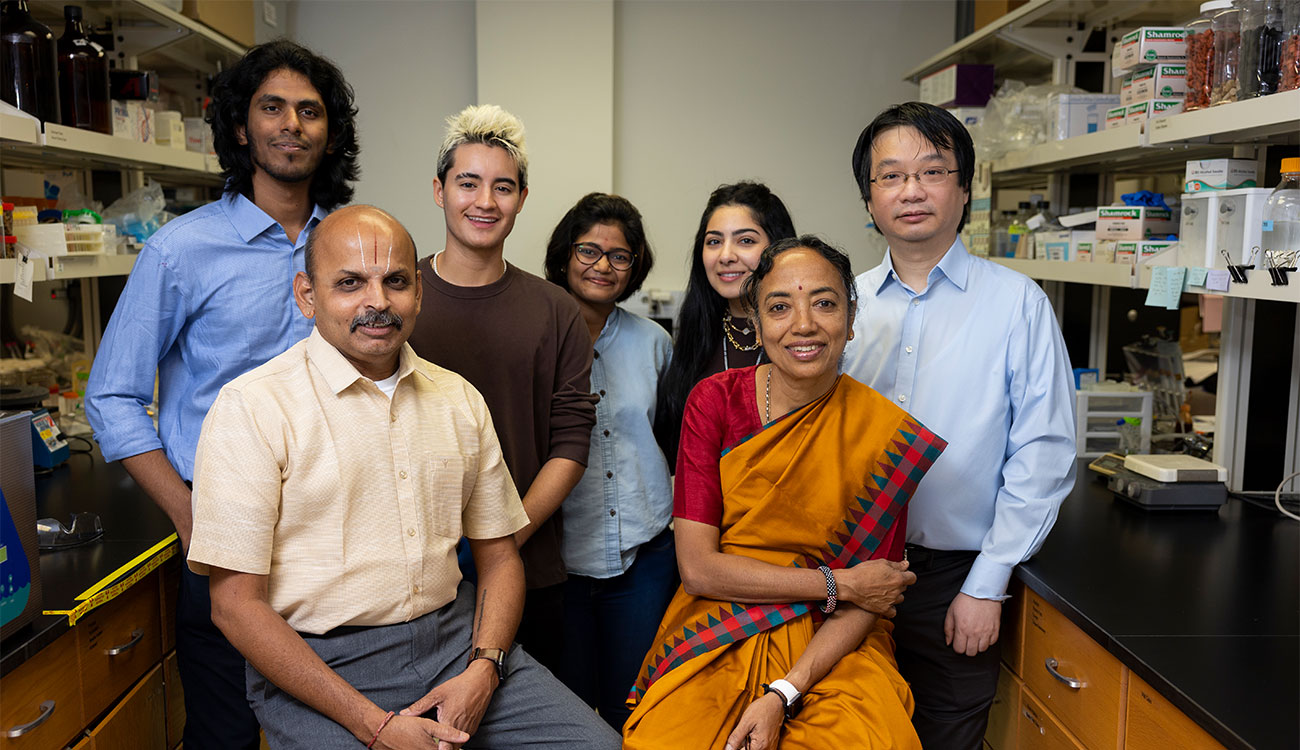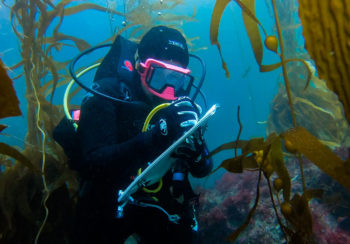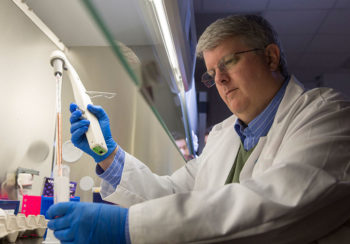As their busy day in India ended, Puliyur and Sheba MohanKumar joined a Zoom call to discuss their successful research careers, their company, and how they juggle it all with their lives as a married couple.
The duo, professors and researchers in the University of Georgia’s College of Veterinary Medicine, met at Madras Veterinary College in India—a moment of instant connection, according to Puliyur.
“The moment I saw her, I knew I was going to get married to her,” he said. “And when I say this to her, she doesn’t believe me, but that is the truth.”
The two went on to study and teach at Kansas State University, where they obtained doctorates and worked on novel research in the same neuroendocrine lab.
Their work is largely in neuro-immuno endocrinology in the context of reproduction and stress. They studied the effects of cytokines on the hypothalamus, an untapped area of discovery that became the groundwork for their many inventions and eventually their company, SG Endocrine. The company is focused on developing innovative technologies for addressing disorders related to brain, endocrine, metabolic and cardiovascular functions.
The key to their research behind several of these inventions is the ability to move nanoparticles through the blood-brain barrier to deliver the cargo they need. That barrier is a border of cells that regulates transfers between the circulatory and central nervous systems. Imagine a pickup truck loaded with cargo—these nanoparticles—that has a gate pass through the barrier. In the context of one of their technologies, Gonads Be Gone, that cargo is released to suppress reproductive hormone production in the hypothalamus as an alternative way to neuter and spay animals. Puliyur earned UGA’s 2023 Entrepreneur of the Year award in part because of this new technology.
After obtaining their doctorates, they married and eventually took positions at Michigan State University, where they developed some of the basis for the nanoparticle delivery systems they have continued to develop at UGA.
Research Communications: Your work has involved the development of nanoparticles that can suppress reproductive hormone function. What drew you to this area of research?
Puliyur: Initially, my interest was to study reproduction in large animals. I was choosing schools where I could do a residency in large animal reproduction. My mentor in India, who was a theriogenologist, told me I should study how the brain regulates reproductive function. So, I applied to Kansas State University, they provided me with an assistantship, and that’s how I got interested in that area and continued our work with the team.
Sheba: After working with plants for my master’s research, working with animals sounded wonderful. When I came across the work that they were doing in this lab, I thought it was really fascinating; there was very little known at that time about the role of the immune system in regulating reproductive function. Plus, not many people had studied the interaction between stress and reproduction. That was another area that I was interested in.
Do the two of you work in the same lab here at UGA?
Sheba: I have my own lab, but we collaborate quite a bit.
Puliyur: We don’t replicate all the instruments because we use similar techniques. So we collaborate quite a bit. We write proposals and get our funding together. Then she has her own collaborators and I have my own collaborators. Our main work is collaborative between us.
Much of your innovation comes from what you found in grant opportunities. Did these lead you in the direction of this research?
Puliyur: We have done quite a bit of basic work, understanding how the reproduction process works, what kind of neurotransmitters are involved, and things of that nature. But it was not translational, meaning it was not going directly to the bedside. We decided when we came to UGA that we were going to translate our work from the laboratory to the bedside—or the clinical side of things.
The first nanoparticle we developed targeted a specific group of neurons in the brain stem. This area is affected in Alzheimer’s disease at least 10 to 15 years before patients exhibit clinical symptoms. Early diagnosis of this disease has always been a challenge. We were one of the first to develop a nanoparticle that can cross from the blood into the brain and enter a specific group of neurons that can be imaged using MRI.
We began our startup company, SG Endocrine, and received funding to develop this nanoparticle for use in Alzheimer’s disease. Working with our collaborator at Emory University, we developed a colony of Alzheimer’s disease models in our laboratory and worked on this compound to show we can detect changes in these groups of neurons in Alzheimer’s disease animals.

Sheba: We also developed another nanoparticle on the side with our postdoc. About 4,000 dogs are being put down in the United States every week because shelters cannot house them. This can be easily avoided if we spay and neuter these animals, but the problem is that surgeries are expensive and many pet owners don’t want to do that. And sometimes these animals are strays. We needed to find an alternative, and this nanoparticle is a beautiful way to address this problem.
Puliyur: One in three client donors want a non-surgical alternative. Currently, there is nothing available. All that associated research inspired us even more to hone this. We have tested it in dogs, cats, and rats. It works both in males and females. Once the study is repeated in a controlled environment, we are ready to go for approval from the FDA and other regulatory authorities.
Inspired by a former classmate, you formed a startup company to have the best shot at securing funding and advancing research. What made you want to form a company instead of just licensing the technology?
Puliyur: Particularly in veterinary medicine, you don’t have granting agencies giving you large grants. We decided the best way to go about doing this is a startup. Also, we wanted to try our hands developing it and taking it further, all the way up to the FDA approval. Then, hopefully, other companies might be interested. We currently have four products and one or two in the pipeline that we are working on. We have one for brain imaging, one for nonsurgical spaying and neutering, one for ovarian cancer, and one for prostate cancer.
We also have a diagnostic kit for breast cancer biomarkers that we have developed using microfluidic technology. It’s a totally different platform. Again, completely translational.
What’s the commercialization process for these types of products?
Puliyur: We have gone through three I-Corps cohorts with Innovation Gateway—one for the brain nanoparticle, one for [the non-surgical spaying and neutering technology] Gonads Be Gone, and one for prostate cancer. All our customer discovery and market research is through that program. I did all three of them, and it was very helpful for me. Sheba went through specific training, the Innovation Bootcamp for women entrepreneurs.
Innovation Gateway has been extremely helpful. All the stuff they do has been a phenomenal help.
It can’t always be easy being married and working together in a business and research lab all the time. How do you make that work?
Puliyur: I can very easily say that our strengths are different. For example, I’m kind of like a grant hog, if you want to call it. I look for these funding opportunities and then for collaborative opportunities, new ideas.
Sheba: He is the advertisement guy. He goes out and talks to people—customer and public relations. He does it all. I’m the one who works behind the scenes. I work with graduate students, with the postdoc, and oversee experiments. We constantly discuss if we need to make changes to protocols, or if we need to make improvements in the process. I manage that, he looks at the big picture, and we work on the grants together.
Puliyur: Sheba’s other strength is that she’s an extremely good wordsmith and editor. If I put together something quickly, she can polish it and make it look good. We know what our strengths are. In my opinion, living together and doing things together helps in that way.
What’s next for the company and your research?
Puliyur: Our trip to India has been very exciting. I had a chance to give several continuing education lectures, and I’ve always asked the participating veterinarians what they would think if there was something available like a non-surgical spaying and neutering nanoparticle that can be injected just once. Unanimously, I’ve had positive responses. Then, by interacting with the regulatory bodies and government agencies and telling them about this product, there is a lot of excitement.
This is going to change the way veterinary medicine is practiced.





